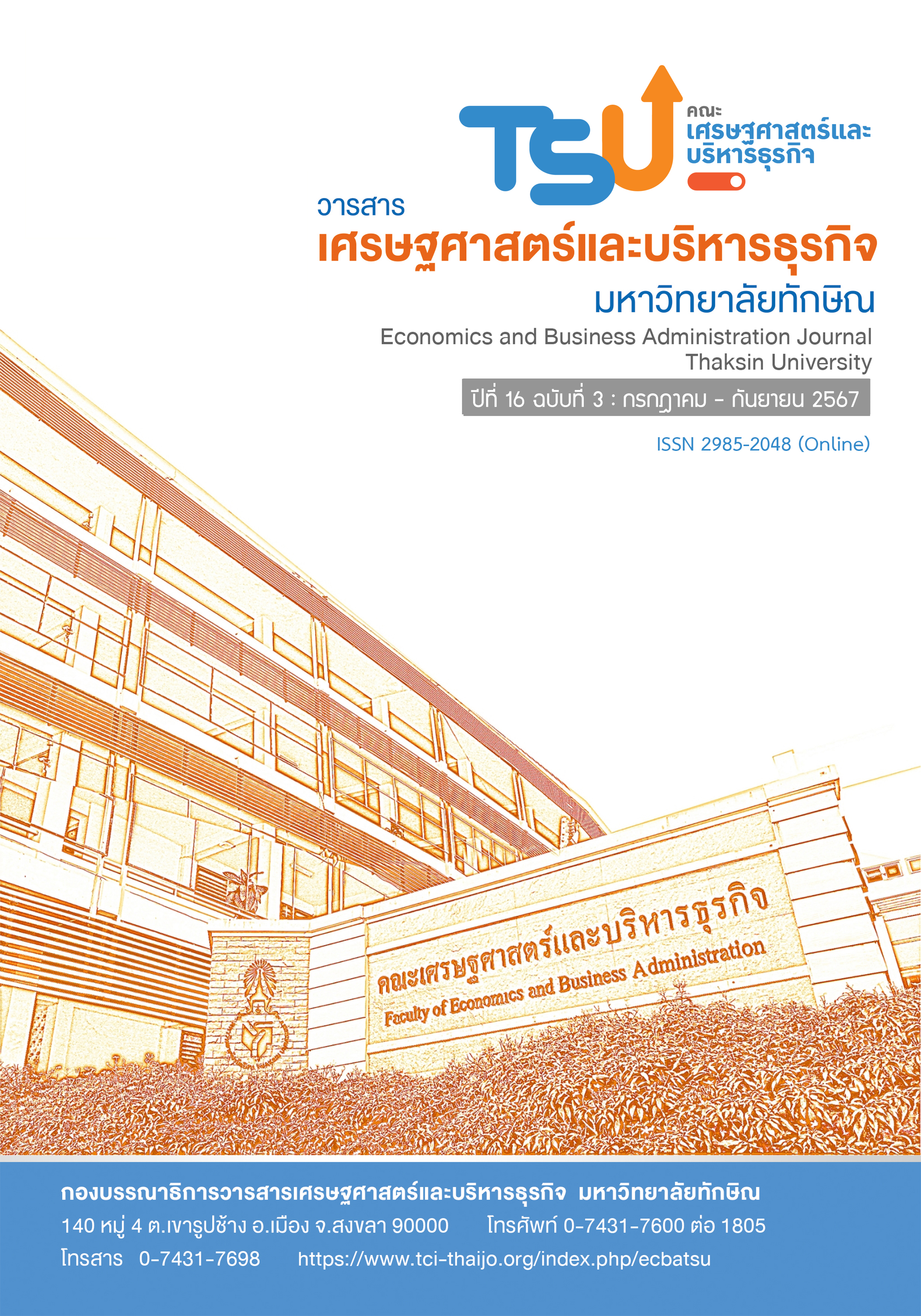ทัศนคติของผู้บริจาคผ่าน Utility Token ของโรงพยาบาลรัฐบาล
DOI:
https://doi.org/10.55164/ecbajournal.v16i3.266583คำสำคัญ:
ปัจจัยจูงใจ, การบริจาค, Utility Token, โรงพยาบาลรัฐบาลบทคัดย่อ
การศึกษานี้เพื่อวิเคราะห์ความสัมพันธ์ระหว่างทัศนคติในการบริจาคเงินให้โรงพยาบาลรัฐบาลของผู้ใช้บริการกับการมอบสิทธิการบริการภายในโรงพยาบาลผ่านการเสนอโทเคนดิจิทัลเพื่อการใช้ประโยชน์ (Utility Token) ให้แก่ผู้บริจาค ทั้งนี้เพื่อเพิ่มการระดมทุนและแก้ปัญหาการขาดแคลนงบประมาณของโรงพยาบาลรัฐ ด้วยวิธีการศึกษาเชิงสำรวจร่วมกับเชิงคุณภาพ จากประชาชนสัญชาติไทยที่ใช้บริการโรงพยาบาลรัฐขนาดใหญ่ (มากกว่า 250 เตียง) ในเขตกรุงเทพมหานคร จำนวน 400 คน โดยใช้แบบสอบถามเป็นเครื่องมือเพื่อรวบรวมข้อมูล วิเคราะห์โดยใช้วิธีการทางสถิติประกอบด้วยค่าความถี่ ค่าร้อยละ ค่าเฉลี่ย ส่วนเบี่ยงเบนมาตรฐาน ตารางไขว้ การทดสอบ t-test และ Chi square-test กำหนดนัยสำคัญทางสถิติที่ระดับ 0.05 ผลการวิจัยพบว่า กลุ่มตัวอย่างส่วนมาก เคยบริจาคให้โรงพยาบาลมาก่อน ทัศนคติส่วนมากต่อการบริจาคให้โรงพยาบาลคือ การทำบุญ ส่วนสิ่งที่กลุ่มตัวอย่างอยากให้โรงพยาบาลดูแลผู้บริจาคมากที่สุดคือ บริการดูแลการนัดรักษาโดยตรง อย่างไรก็ตาม เมื่อมีการเสนอ Utility Token ให้แก่ผู้บริจาคพบว่ากลุ่มตัวอย่างมีแนวโน้มที่จะบริจาคให้โรงพยาบาลรัฐมากขึ้นอย่างมีนัยสำคัญ โดยกลุ่มตัวอย่างที่เคยบริจาคให้โรงพยาบาลมาก่อนจะบริจาคมากหรือบ่อยครั้งขึ้น และในกลุ่มตัวอย่างที่ไม่เคยบริจาคให้โรงพยาบาลมาก่อนมีแนวโน้มจะเปลี่ยนใจมาบริจาคให้โรงพยาบาล ผลการศึกษาเชิงคุณภาพพบว่าผู้ใช้บริการในโรงพยาบาลรัฐทั้งที่เคยและไม่เคยบริจาค มีการรับรู้ถึงความขาดแคลนเงินทุน และคิดว่าโรงพยาบาลรัฐควรได้รับงบประมาณเพื่อพัฒนาการบริการให้ดียิ่งขึ้น การเสนอสิทธิการให้บริการผ่าน Utility Token สามารถสร้างส่งเสริมทัศนคติในทางบวกต่อการบริจาคเงินของผู้ใช้บริการในโรงพยาบาลรัฐได้
เอกสารอ้างอิง
Act on the Administration of State Affairs. (1991). Legal Database. Retrieve 10 April 2023, from http://regu.tu.ac.th/quesdata/Data/A81.pdf
Atkinson, R. (1989). Altruism in Nonprofit Organizations. BCL Rev., 31, 501.
Andreoni, J. (1990). Impure Altruism and Donations to Public Goods: A Theory of Warm-Glow Giving. The Economic Journal, 100(401), 464–477.
Arslanian, H. (2022). Utility Tokens and Social Tokens. In the Book of Crypto: The Complete Guide to Understanding Bitcoin, Cryptocurrencies and Digital Assets. Cham: Springer International Publishing.
Bamrungchit, S., & Panthanuwong A. (2021). Donors’ Media Exposure, Opinion towards Communication and Intention to Donate to Siriraj Foundation in COVID-19 Pandemic. Media and Communication Inquiry, 3(3), 1-11.
Bekkers, R., & Wiepking, P. (2011). Who Gives? A literature Review of Predictors of Charitable giving Part One: Religion, Education, Age and Socialisation.
Campino, J., Brochado, A., & Rosa, Á. (2022). Initial Coin Offerings (ICOs): Why do They Succeed?. Financial Innovation, 8(1), 17.
Chell, K., Davison, T. E., Masser, B., & Jensen, K. (2018). A Systematic Review of Incentives in Blood Donation. Transfusion, 58(1), 242-254.
Drasch, B. J., Fridgen, G., Manner-Romberg, T., Nolting, F. M., & Radszuwill, S. (2020). The Token’s Secret: The Two-faced Financial Incentive of the Token Economy. Electronic Markets, 30, 557-567.
Farrow, K., Grolleau, G., & Ibanez, L. (2017). Social Norms and Pro-environmental Behavior: A Review of the Evidence. Ecological Economics, 140, 1-13.
Glazer, A., & Konrad, K. A. (1996). A signaling explanation for charity. The American Economic Review, 86(4), 1019-1028.
Goette, L., & Stutzer, A. (2019). Blood Donations and Incentives: Evidence from a Field Experiment. Journal of Economic Behavior & Organization, 170, 52-74. DOI: https://doi.org/10.1016/j.jebo.2019.11.021
Graça, S. S. (2022). Increasing Donor’s Perceived Value from Charitable Involvement: A Multi-segment Approach to the American Donor Market. International Review on Public and Nonprofit Marketing, 1-24. DOI: https://doi.org/10.1007/s12208-022-00355-1
Hartmann, F., Grottolo, G., Wang, X., & Lunesu, M. I. (2019). Alternative Fundraising: Success Factors for Blockchain-based vs. Conventional Crowdfunding. In 2019 IEEE International Workshop on Blockchain Oriented Software Engineering (IWBOSE). IEEE.
Hong, J., & Loke, A. Y. (2011). Hong Kong Young People’s Blood Donation Behavior. Asian Journal of Transfusion Science, 5(1), 49.
Howden-Chapman, P., Carter, J., & Woods, N. (1996). Blood Money: Blood Donors' Attitudes to Changes in the New Zealand Blood Transfusion Service. BMJ, 312(7039), 1131-1132.
Jonathan, L. E. V. Y. (2016). Altruism and the Origins of Nonprofit Philanthropy. Philanthropy in Democratic Societies: History, Institutions, Values, 19.
Lacetera, N., & Macis, M. (2010). Do All Material Incentives for Pro-social Activities Backfire? The Response to Cash and Non-cash Incentives for Blood Donations. Journal of Economic Psychology, 31(4), 738-748.
Lambert, T., Liebau, D., & Roosenboom, P. (2021). Security Token Offerings. Small Business Economics, 59, 299–325.
Louis, W. R., Thomas, E., Chapman, C. M., Achia, T., Wibisono, S., Mirnajafi, Z., & Droogendyk, L. (2019). Emerging Research on Intergroup Prosociality: Group Members' Charitable Giving, Positive Contact, Allyship, and Solidarity with Others. Social and Personality Psychology Compass, 13(3), e12436.
National Health Security Act. (2002). Legal Database. Retrieve 10 April 2023, from http://nih.dmsc.moph.go.th/law/pdf/031.pdf
Ni, T., Wang, X., Wang, Y., & Li, M. (2022) Can the Deferred Donation Deduction Policy Promote Corporate Charitable Donations? Empirical Evidence from China, Emerging Markets Finance and Trade, 58(8), 2203-17.
Suppasilp, C. (2015). Factors Affecting Donations to Siriraj Foundation. Research Report, Thammasat University. Retrieve 10 April 2023, from http://ethesisarchive.library.tu.ac.th/thesis/2016/TU_2016_5804010402_6590_4715.pdf
Vesterlund, L. (2006). Why do people give. The nonprofit sector: A research handbook, 2, 168-190.
Wang, M., Cai, M., Guo, S., Li, M., Tan, X., Ou, C., & Lu, X. (2023). Large-Scale Medical Crowdfunding Data Reveal Determinants and Preferences of Donation Behaviors. IEEE Transactions on Computational Social Systems.
Whitehead, M., & Dahlgren, G. (1991). What Can be Done About Inequalities in Health?. The Lancet, 338(8774), 1059-1063.
Yamane, T. (1973). Statistics: an introductory analysis-3.
Ye, N., Teng, L., Yu, Y., & Wang, Y. (2015). “What’s in it for me?”: The Effect of Donation Outcomes on Donation Behavior. Journal of Business Research, 68(3), 480–486.
ดาวน์โหลด
เผยแพร่แล้ว
รูปแบบการอ้างอิง
ฉบับ
ประเภทบทความ
สัญญาอนุญาต
ลิขสิทธิ์ (c) 2024 Faculty of Economics and Business Administration, Thaksin University

อนุญาตภายใต้เงื่อนไข Creative Commons Attribution-NonCommercial-NoDerivatives 4.0 International License.




